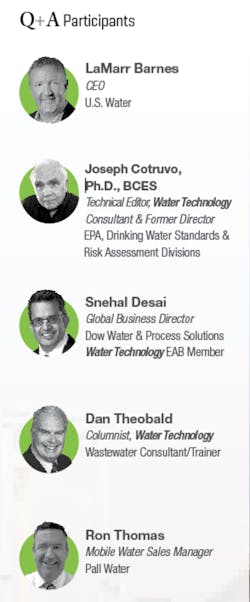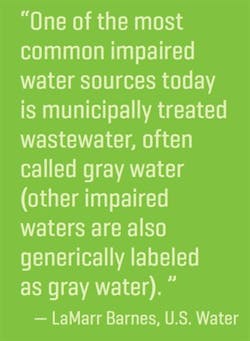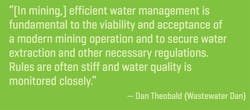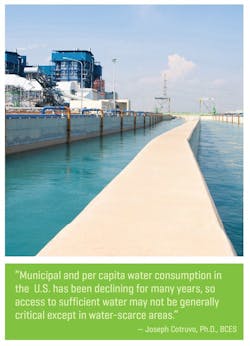To learn more about the path to good water stewardship, Water Technology editors talked with members of our Editorial Advisory Board (EAB) and other industry experts about the current state of industrial water. ey shared their insights on the challenges that facilities face and how emerging and improved technologies can help protect water’s future. They also share best practices that help conserve this valuable resource, make processes more efficient and ultimately lower production costs. If you have further questions or comments regarding the state of industrial water in 2017, please email them to us — [email protected].
Have you seen any innovations in source water intake treatment? Other than recycled water, what are the most common sources for process water?
Barnes: Most innovation has been in the choice of alternatives to traditional a such as potable freshwater or ground or surface water that could otherwise be used for potable or agricultural use. Many industrial facilities that did not use municipal potable water have historically used private water sources (private wells, or intake of surface water from lakes or rivers).
Pressure to reduce industrial use of these sources of water has led to significant increase in the use of impaired waters as source water. This has increased the amount of on-site reuse as well as exploring alternative impaired water sources.
One of the most common impaired water sources today is municipally treated wastewater, often called gray water (other impaired waters are also generically labeled as gray water). This low-cost, or sometimes free, water source is abundant and does not strain local water sources. Gray water makeup can vary from hour to hour or day to day and is rich in nutrients. If left untreated, gray water can lead to scale formation or other biological concerns on treatment equipment. However, innovative engineering and treatment technologies can treat common issues surrounding gray water use.
Desai: In general, surface waters remain a prominent source water for industrial facilities. Since 1950, the U.S. Geological Survey (see https://pubs.usgs.gov/fs/2014/3109/pdf/fs2014-3109.pdf ) has been capturing water withdrawal trends at five-year intervals. In its last report in 2010, [it] found that surface waters continue to be 78 percent of all withdrawals. This trend has not shifted much.
However, what we are seeing is that recycled wastewater [use] is a growing trend. This evolving trend is driven both by increasing competition for available water as well as discharge regulations, which have become stricter in many parts of the world.
Regardless [if] the water source is surface or otherwise, technology to make water treatment more efficient has been advancing in [these] existing categories:
- Coarse particle filtration
- Ultrafiltration,
- Reverse osmosis (RO)
- Ion exchange
Each of these technologies continues to evolve to expand our collective capabilities to reduce treatment system capital expenses, lower energy costs, improve durability and enhance operating ranges (higher temperatures and wider pH tolerance).
Theobald: Process water is not considered drinkable (not drinking water) and is basically used in relation to industrial plants, industrial processes and production facilities. Process water is subjected to a substantial water treatment and includes:: ion removed water, purified water, ultra-pure water, cooling water, rinse and wash water, softened water, brewing water, media-filtered water and desalination water using RO.
What industries face the toughest water challenges?
Barnes: The electrical power generation sector has the highest water use and faces the largest challenges over time. The use of gray water is significantly increasing in this market, and regulation of discharge of waters from ash ponds, etc., is having an immediate effect on coal-fired plants.
Generically, all the other heavy industries (refining, petrochemical and mining) face issues here but are very impacted by local conditions (local water scarcity, state water discharge regulations, proximity to other industrial facilities competing for water and contributing contaminants to the same receiving waters).
Ethanol producers are also often under scrutiny for their water usage, because it takes on average 2.5 to 4.5 gallons of water to produce one gallon of ethanol. As this industry continues to grow, facilities are looking at alternative water sources and implementing water recycling or reuse practices.
Cotruvo: Agriculture and beverage production face some of the toughest water challenges.
Desai: It is hard to pick a single industry because the challenges are many and quite diverse. In no particular order:
- Mining industries face challenges with acid drainage.
- Large chemical and petrochemical facilities with extremely large wastewater streams are being challenged to minimize liquid discharge.
- Power plants located close to municipalities continue to be pressured to manage trace impurities in their wastewaters.
- Microelectronics plants are having to achieve heretofore never-before-seen water purity requirements owing to transistor miniaturization.
- Food and beverage producers can be very large local water consumers and have concern that they will lose their supply if they are not perceived as good water stewards.
Theobald: Energy production uses a great deal more water than you might first imagine. All sources of energy require water at some point in production, whether it is during the extraction of raw materials or other processes.
These energy-intensive applications and processes include:
- Oil and gas production and refining
- Coal-fired power generation
- Nuclear power generation
- Cooling in thermal processes
- Irrigation in the cultivation of crops for biofuels
- Powering turbines for hydropower
As the demand for energy increases, it may mean an approximately 80 percent increase in water consumption by the energy sectors, which may result in as much as 35 percent shortfall between supply and demand as early as 2035. Energy and water are inseparably connected.
Mining and extractive industries have a tight kinship with water and cast in place innovative processes to reuse and recycle the water they use. On one hand, their operations need water for mineral processing and metal recovery and to control dust. On the other hand, to avoid tensions with other water users, they need to ensure that they are not depleting or polluting the water resources on which other businesses and local communities also rely. Efficient water management is fundamental to the viability and acceptance of a modern mining operation and to secure water extraction and other necessary regulations. Rules are often stiff and water quality is monitored closely.
The pharmaceutical industry faces water challenges from various angles. Water is both a decisive ingredient in the production and in the taking of many medicines, and the character of the water supply at the usage level and for patients is vital. The pharmaceutical industry faces unique challenges in removing its product from water post-production, post-consumer usage and post-disposal to ward off the buildup of chemicals in the water network. The [removal of] its product from water may become a reputation issue for the pharmaceutical industry as it looks at the entire presence of its product and safe [disposal].
Automotive and the industrial process industries are using water to heat, cool and clean. The quality and consistency of the supply is important. Many companies have extensive supply chains so the challenge of water and its impact are far reaching. These companies need to be proficient water stewards and work well with their neighbors in the water supply sources they share but also supportive of the needs of their value chain.
As with retail and consumer businesses, many companies have located their operations or suppliers in countries in which costs are lower. Countries important to a company’s growth often happen to be in areas that also suffer water stress or have greater unpredictability in their weather patterns. Maintaining product supply may require a revision in the business model or investment in water management technologies for themselves and their value chain.
Thomas: 2017 will prove to be an important year for industrial wastewater. There is a lot of ongoing work regarding the Environmental Protection Agency’s (EPA) proposed regulations for effluent limitation guidelines and standards for steam electric power generation in both new and existing power plants. This work has been ramping up for quite some time and primarily impacts coal-fired power plants. The new regulations focus on the reduction of numerical/discharge limits in wastewater.
Due to the complexity of meeting regulatory compliance, power generation operators are engaging with engineering and environmental firms to understand a path forward that meets those reductions. Operators are looking to identify technologies that will help achieve these new limits, and they are often looking to build a water treatment plant as well. This is a very big task and one of the toughest challenges for industries.
What are some of the most difficult water challenges facing industries in 2017?
Barnes: Of course, sourcing water and properly planning for discharge are the main concerns. This drives water reuse, and water reuse and recycling can be [some] of the most difficult water treatment processes to design and implement [because] they often require a combination of chemical and mechanical solutions to be successful.
Plant design, operating conditions, available water quality and quantity, available personnel and training, capital and operating budgets, environmental restrictions, and other regulations must also be considered. A factor often overlooked in designing water recycle/reuse systems is the variability in water quality and flow rates – both seasonally and due to operational schedules.
Desai: The water challenge does not change drastically from year to year. A meaningful trend to watch is which of the many levers affecting water management and use are shifting. Waste discharge and pollution, for example, are obvious areas that have intensified in focus whether in China or the U.S.
Theobald: Protecting the environment os one challenge. Both water customers and the wider global society are increasingly recognizing the importance of their surroundings. The water sector relies on and contributes to the caliber and accessibility of natural water resources and natural resources more generally.
Another is water scarcity. Given the disproportionate distribution of the population and water resources across the world, much water for industrial use is frequently drawn from areas where water resources are under pressure. Many affected areas are also forecast to experience population growth.
Thomas: The challenges are similar across the U.S., but vary in order and magnitude by region. Plant managers can summarize industrial water challenges in one question: How can I do more in my plant while reducing costs and footprint? Cost and compliance pressures will continue in 2017, and will require comprehensive solutions. Technology that improves the cost of operation, reduces required maintenance or simplifies an existing process is always of interest and will become more critical in 2017.
In what technological areas do you see the potential for the most improvement?
Barnes: There are many areas where improvement is occurring. The first is not really technological but rather philosophical. Segregating water streams instead of aggregating, followed by minimal treatment recycle/reuse is the trend. From a technological view, economical specific ion removal technologies are needed, along with lower total cost membrane solutions in many areas. Sensing technologies that can drive automation and control upgrades is another important area. Finally, for the high-strength/high-concentration final waste streams, more economical evaporation technologies or methods to change the high-strength waste into beneficial end products will be needed. The cost of disposal or evaporation of these final waste streams often make complete water reuse (or zero liquid discharge) uneconomical.
Cotruvo: The best potential technologies are those in the recovery of water from brines, zero liquid discharge and more energy-efficient membrane processes.
Desai: The industry has the technology that can help solve the water challenges identified today. I know because Dow offers [a broad and deep] portfolio of water treatment solutions. What we need is creative thinking and improvement in the way we use technology and in the way we collaborate.
Minimal liquid discharge (MLD) – a concept Dow introduced in 2015 – continues to show huge potential. This approach takes a host of factors into consideration to build a multitechnology system with the original equipment manufacturer partner. At 95 percent water recovery rate, an MLD approach costs half as much as a direct-to-zero liquid discharge system.
Reducing energy use in water treatment is another area where technology can continue to up the game. Later this year, we are expecting to introduce more product options…[to deliver] more clean water at less overall energy requirements.
Theobald: Most conventionally operated wastewater and water treatment plants require great energy expenditure. As much as 120,000 water treatment plants and 10,000 wastewater treatment plants consume at least 3 percent of the nation’s total electricity. To decrease consumption, it should be encouraged that water treatment facilities use energy saving standards and employ alternative energy sources using new technology.
Successful alternative energy generation techniques and engineering science include a solar-microbial device that uses wastewater and sunlight to generate clean energy and electricity-producing microbes that treat wastewater and provide a power source.
For nutrient reduction and recovery, most nitrogen and phosphorus removal during the wastewater treatment process is vital to prevent water contamination. Besides much of either nutrient, nitrogen and phosphorus, can negatively impact aquatic ecosystems and human health and result in toxic algal blooms.
To battle this problem, levels of total nitrogen should be kept less than or equal to 3.0 milligrams per liter for biological nutrient removal and enhanced nutrient removal. Along with this, plans should include striving to achieve more energy-efficient nutrient reduction practices and nutrient recovery technologies that are cost-effective and sustainable.
Ralph Exton, Chief Marketing Officer—GE’s Water & Process Technologies.
Image courtesy of GE
Technology is the bridge to creating solutions out of challenges. At GE Water & Process Technologies, we always try to align our technology innovation to those challenges most affecting our customer base and to solve for the critical outcomes we know could have a large impact on our customers’ operations. Challenges vary plant to plant, but three shared struggles, and opportunities for improvement, center around energy efficiency, water scarcity and water infrastructure.
An opportunity exists to transform how we view wastewater treatment, and move to more strategic and innovative infrastructure solutions where wastewater plants are not disposal facilities, but rather resource recovery facilities that produce clean water, nutrients, and energy. The technology already exists to reuse water and to harness energy from wastewater; and companies like GE Water & Process Technologies have these capabilities. Now, implementation and policy drivers are the key to adoption.
Also, water infrastructure around the world is in crisis. Many water assets like piping and distribution are outdated, unreliable and in some cases unsafe, resulting in health and environmental hazards that could affect millions of people. Central to the problem is that providers are oftentimes unaware of an issue, such as a pipe burst, until it literally surfaces. Without real-time insight into network infrastructure conditions, operators are trapped in a negative reactive cycle. With the advent of Software as a Service, Water & Process Technologies can help connect assets into a real-time monitoring network that will reduce the amount of time it takes to discover leaks, water quality issues, and other service disruptions. This will enable utilities to fix problems more quickly, reduce unplanned outages and limit damage to other pieces of critical infrastructure.
Thomas: The market continues to see improvements in membrane technology that incorporate improved materials and manufacturing processes that lead to more robust products.
Consumable filter products continue to improve across the board with new applications, new materials and higher performance. Electrolytic technologies associated with ion exchange, solids removal and disinfection grow and improve as well.
Resin companies continue to develop higher capacity resins and some unique specialty resins. The research and development groups within all the segments are doing some good work.
It is a very exciting time to be in the water business.
Do you perceive that most manufacturers and process industry facility managers recognize and respect their roles as stewards of water’s future?
Barnes: This is changing rapidly. The Corporate Water Disclosure project report for 2016 from CDP shows higher response rates, larger reported water impact, and more companies measuring and reporting on water issues. We also see higher awareness and interest in reducing water impacts from our customers.
Desai: Absolutely! The emphasis on a circular economy is increasingly becoming a mindset in the industry across all players.
Thomas: Absolutely, it is a non-negotiable given the regulatory environment and the nature of the resource. Industries that use and dispose of process water have to be onboard with responsible water management. Corporate leadership all the way down to the individual operator typically have yearly goals to achieve that are associated with water management and understand the importance of good stewardship of water resources.
The implications of releasing wastewater above total maximum daily limits or exceeding specified parameters for a given water district can have negative impacts on the operators’ brand, current and future permitting, and balance sheet, as well as the potential environmental impact on marine life or contaminating a water supply.
How do recycling and reuse improve efficiencies and lower costs?
Barnes: The best projects provide an immediate economic benefit versus traditional cost structures – these low-hanging-fruit projects reduce source water and discharge costs without significant cost of implementation. They also often result in an energy recovery in the form of heat, reducing energy input to a process, which further reduces operational cost.
Projects with a higher cost of implementation generally require a different set of drivers – inability to source enough water to operate a facility, inability to discharge water (or significantly increased costs or fines to do so), or sometimes just good stewardship goals, even when it comes at a net increase in operating costs.
Desai: I might add “reduce” to the equation of reuse and recycle. All three are important in industrial processes. Many industries have a laser focus on reducing water usage as a primary way to reduce water acquisition and treatment costs. Once minimized, water recycling done right can lower costs by lowering water acquisition costs as well as purification costs since, in some industrial streams, the wastewater purification and recycling is less costly than disposal costs.
Theobald: For water efficiency increases, implement the general option to cut the stream of water. Also modify equipment by installing water-saving devices, replacing existing equipment with more water efficient equipment. Implement water recycling and reuse, and change to waterless processes [when possible].
For energy efficiency improvement, an innovative approach can include the institution of a prognostic model for an entire process based on unique equations. This is considered a closed-loop application, meaning the model reads input values from the plant, evaluates the operating conditions, calculates the conditions under which the plant will achieve the most energy efficiency improvement, then prompts the plant to the new target conditions.
Typically, many measured inputs – such as temperatures, pressures, current rates and physical arrangements – are available. Additional inputs include changing economic values, such as current prices, supply/demand constraints of new utilities and products. The model manages many outputs for adjusting conditions of the process and includes built-in constraints to ensure the safety and operability of the target conditions.
Thomas: The operator will use the costs to acquire and dispose of water which can range for $1 to $12 per kgal depending on the geographic location at a given flow rate for the project, then comparing those calculations to the capital or operating costs. The comparison of invested capital overlaid on the known expense of continuing with current practices will give a projected return on investment. [After] the study, it becomes a go/no-go decision.
Another long-term consideration is [to ask] what will not doing something today cost us in the long term, even if it is break even today? The basic business assumptions are that costs in general and regulatory requirements will continue to grow over time. In both scenarios the operator is buying a long-term solution, which is an asset on the balance sheet or a fixed operating cost, while eliminating a significant portion of a direct recurring expense.
Can all process plants recycle and reuse their wastewater? What, if any, are the limitations?
Barnes: There are always opportunities. It comes down to economic drivers first, societal drivers if the economics are not enough – as discussed above. Some industries, such as the food and beverage industry, also have regulations that provide additional challenges – such as complying with food safety rules.
Cotruvo: Technology is capable of allowing all water to be reused. The issue is always the cost of recycling versus other available sources.
Desai: Most can do so. The issue is not recycle/reuse but the level of water that can be recovered for recycling and the quality of the feedwater. New plant builds can take advantage of the latest technologies to achieve state-of-the-art recycling in their operations.
The vast majority of water treatment plants at legacy facilities may require changes depending on their current design and set-up. The changes required could range from something as simple as changing the type of resins or RO membranes, adding pre- or post-treatment solutions, to some level of the redesign.
Challenging feedwater can be treated with solutions such as DOW FILMTEC FORTILIFE antifouling RO products for wastewater recycling as well as another ultra-high pressure RO membrane for increased water recovery.
After these considerations, the decision whether to recycle or reuse water becomes a cost-benefit analysis of the system required versus the total cost of water, as well as an issue of regulatory requirements.
Thomas: All wastewater streams are potential candidates for recycle/reuse. With a little pre-work, it can be qualified or disqualified. This process starts with an analysis of the water stream, constituents, flow rates, how backwash and reject streams can be treated, permit limits, and the actual location layout and a variety of other milestones. In some cases the current method is the best available technology. The best path will be vetted out going through the process.
How do process plants recycle and reuse their wastewater? What are the limitations?
Theobald: Treatment technologies for water reuse are, for the most part, derived from physical, chemical, and biological processes used for wastewater and drinking water. Treatment technologies include: membrane bioreactors, micro-filtration, ultrafiltration, nanofiltration, and RO, which are especially efficient for developing high-quality reclaimed water.
All of these technologies must comply with strict purification standards, and guarantee process water free from bacteria and viruses. Typical technologies for reuse include ultrafiltration, membrane bioreactor, RO, aerobic treatments, ozonation, ultraviolet treatment and advanced oxidation.
What are some of the toughest general challenges faced by industrial wastewater treatment, and what are the most effective treatments for them?
Barnes: This is a tough question to answer. I think the largest challenge is in defining an approach to take. Since issues are complex and local, and vary greatly, there is not one general technological challenge. One thing to think about is that the cost of many reuse solutions still outweighs the benefits. This is due to the fact that in most parts of the U.S., water is still generally available; costs are still low, and discharge is still possible. As this changes, current solutions will become more cost-effective. In the meantime, we need technologies that can reduce costs of things like specific ion removal (versus non-specific technologies such as membranes) or of disposal of high-strength final waste.
Cotruvo: Continually more stringent wastewater discharge controls and tighter water quality requirements are some general challenges. Ultimately, zero discharge can avoid all the requirements.
Theobald: Nutrient removal is a tough challenge. This forces more plants to add great amounts of chemicals to polish their effluents. The other unintended effect is that multiple systems now need more upkeep.
Some wastewater plant operators have trouble maintaining complicated systems, while keeping prices down. Eventually, chemical stabilization methods will displace some of the biological techniques. For example, one problem area is biological phosphorus removal followed by anaerobic digestion. The unfortunate consequence is the release of phosphorus back into the plant, whereas chemical phosphorus removal permanently ties up phosphorus until it leaves the system. An effective treatment for removing nutrients, total nitrogen and total phosphorus includes a process known as integrated fixed-film activated sludge.
Are there any other insights about industrial water that you would like to share?
Thomas: Technology and design improvements are occurring all the time. [Water professionals should] engage suppliers in a dialogue about what they have to offer or what’s new and compare it with the current state of the operation. The more people you dialog with is an exercise in identifying contacts and companies that may fit a business need in the future. Stronger networks provide better solutions…The truth is, these are extremely valuable exercises and should be revisited as a part of a continuous improvement environment. Economics, business, water, and customers are always changing. There may be a breakthrough sitting in a project file that was not feasible two years ago that today is a strong project for review and to move forward with funding.
Desai:Something that continues to surprise me is how little some plants seem to know about their total water cost. Water is used as production input, in processes, and as part of utility, and it is not often that we come across an operator who has aggregated their costs and found efficient and effective ways to close the resource use loop. With changing regulations, increasing challenging water sourcing and the rising cost of water, it pays to review the total cost of water and realize that small changes around the plant can make a huge impact on operating expenses.









